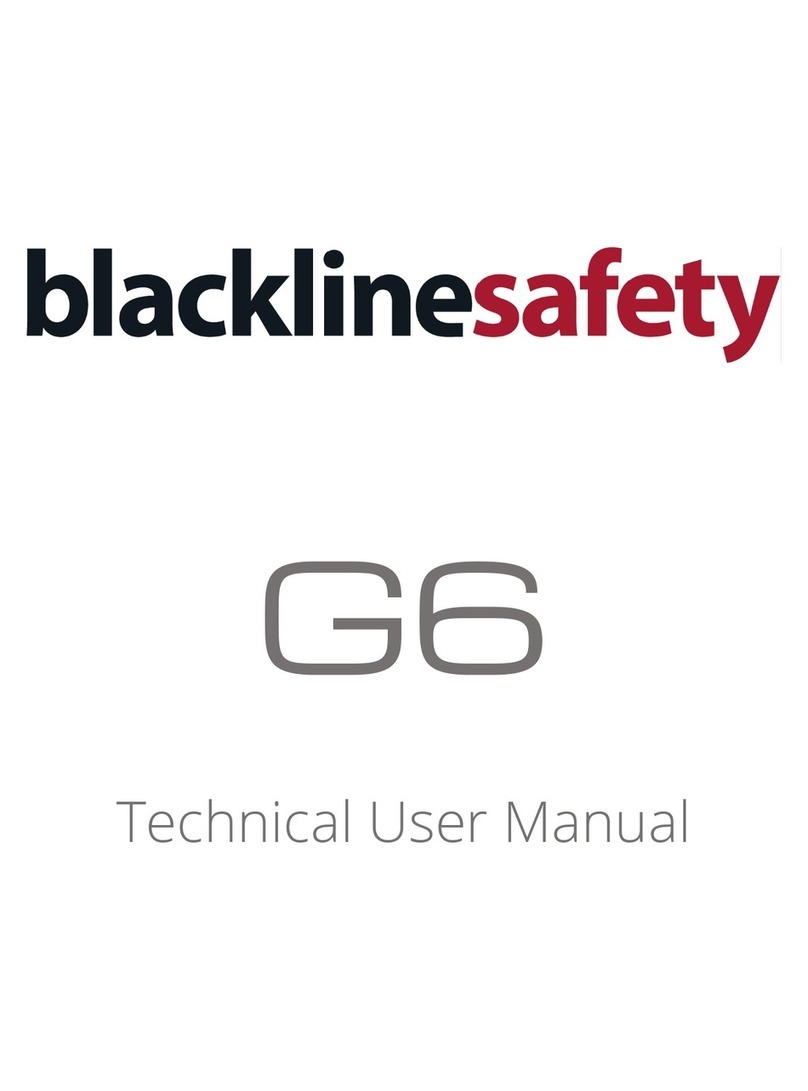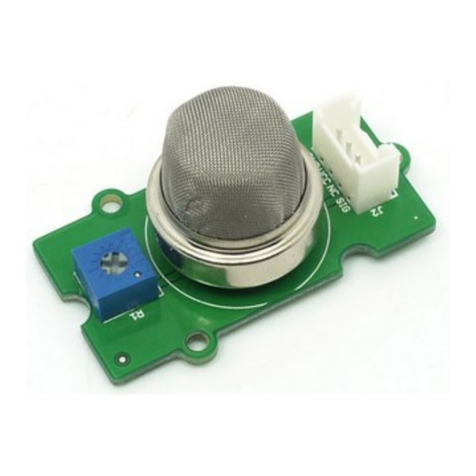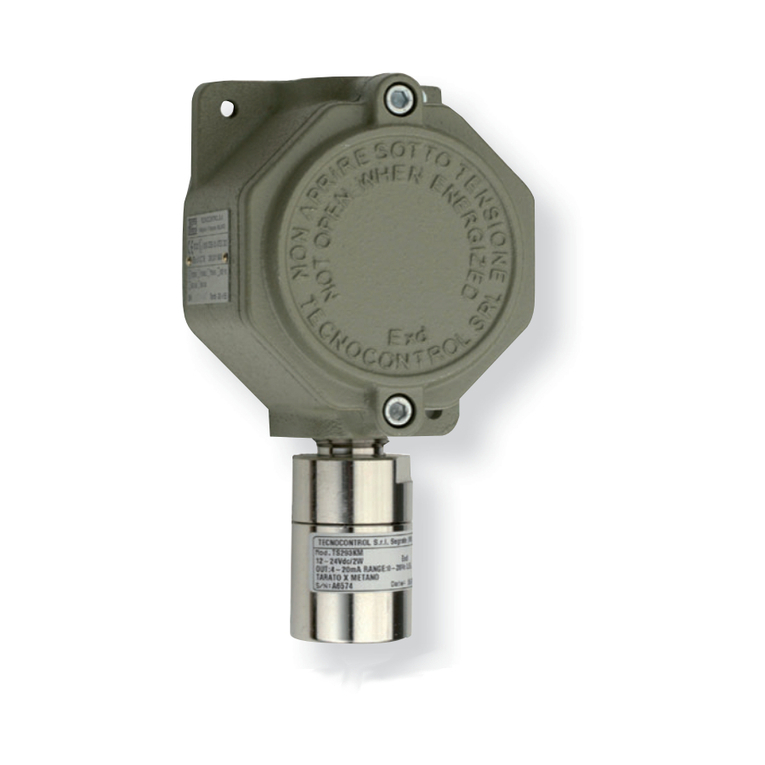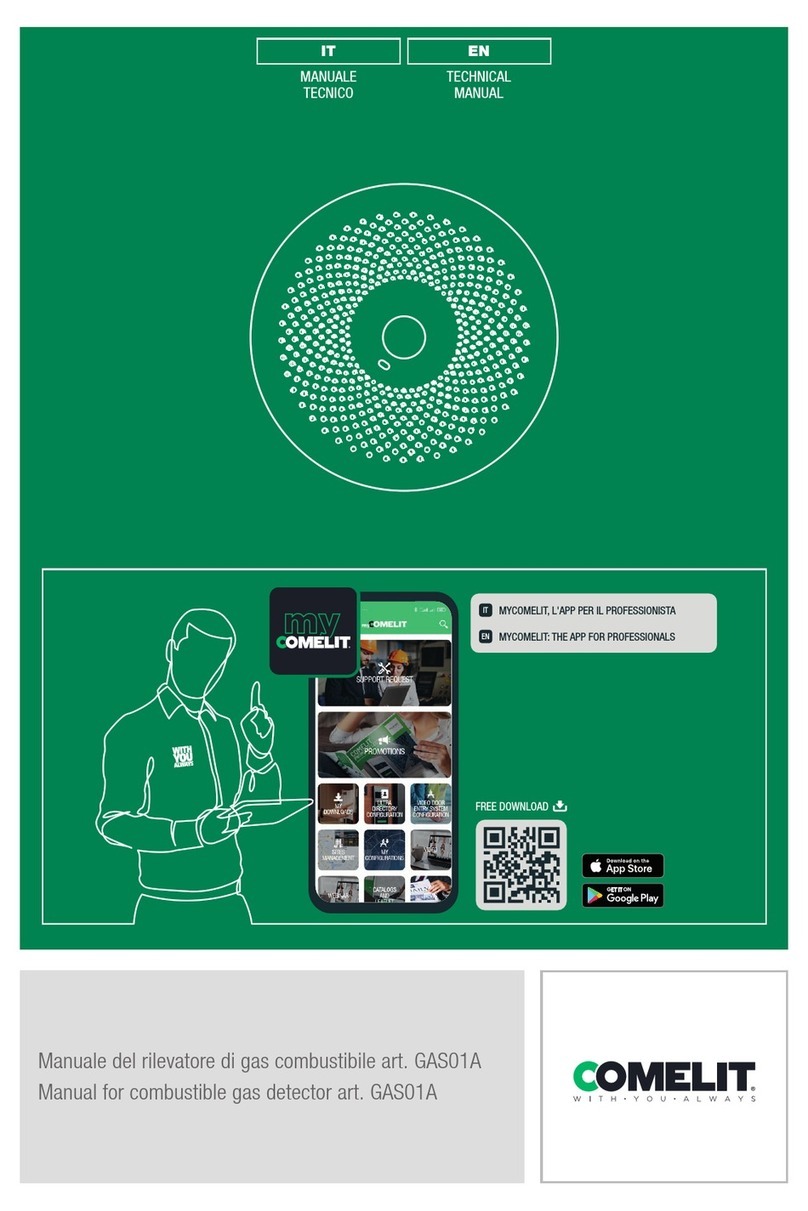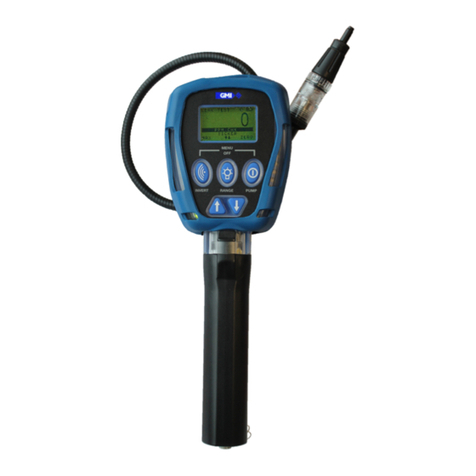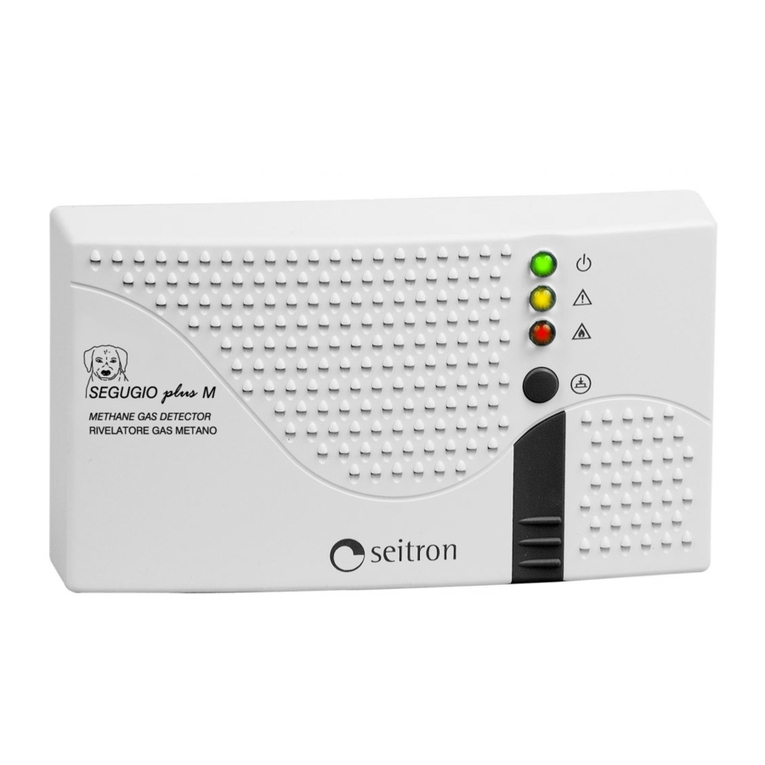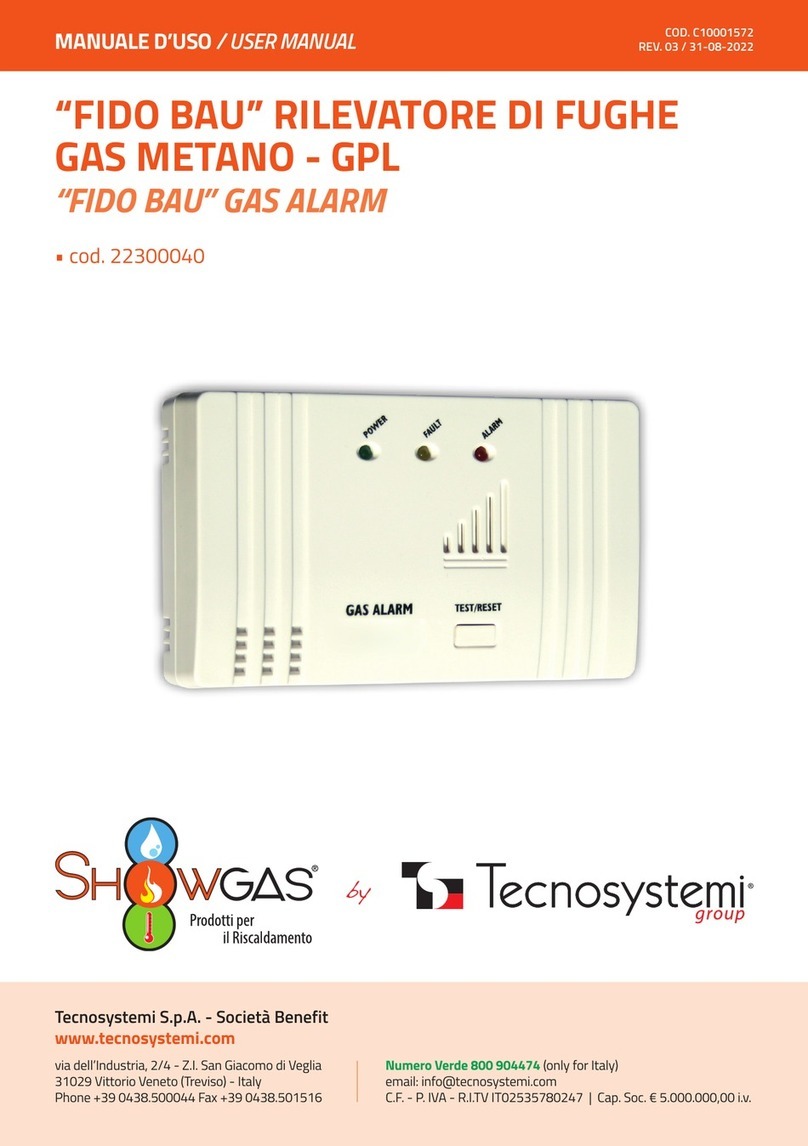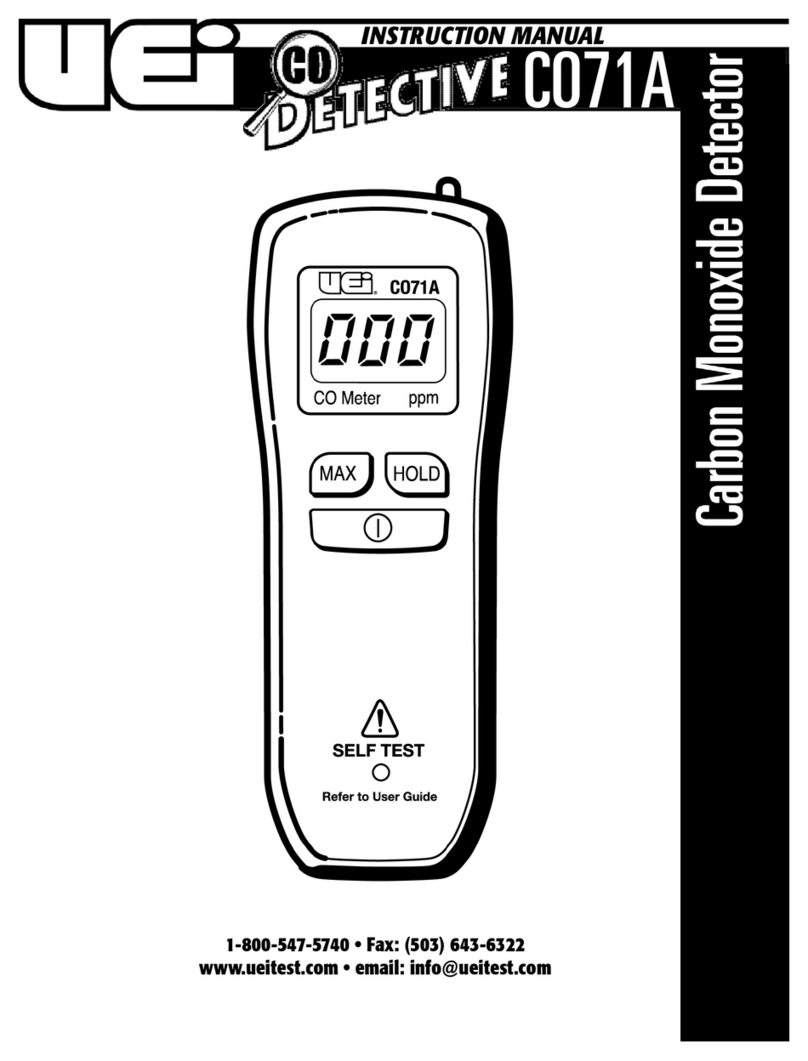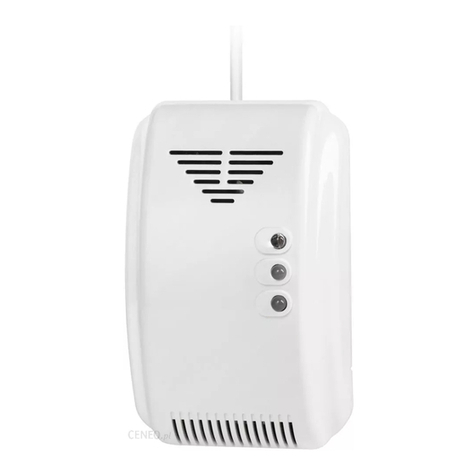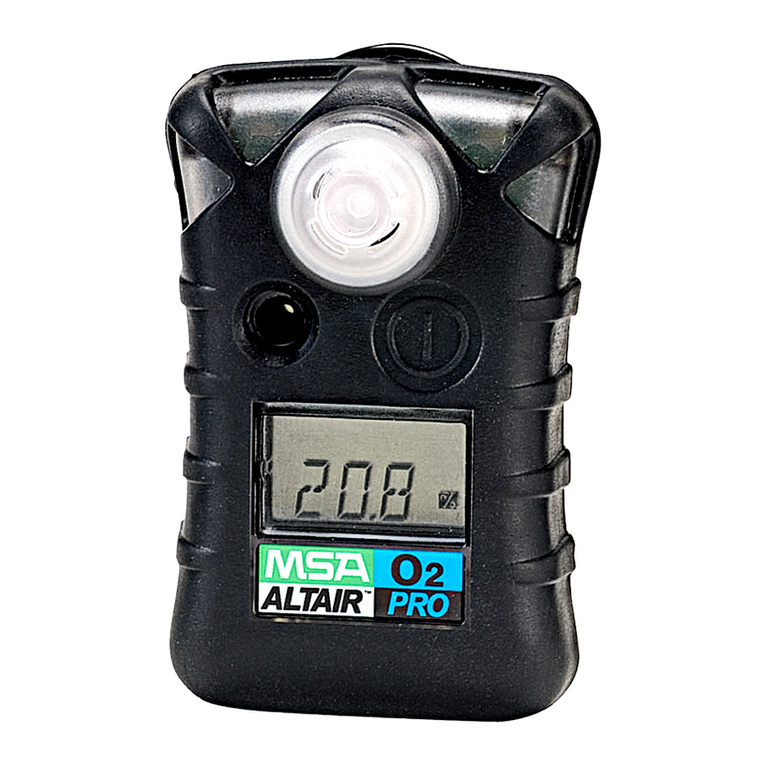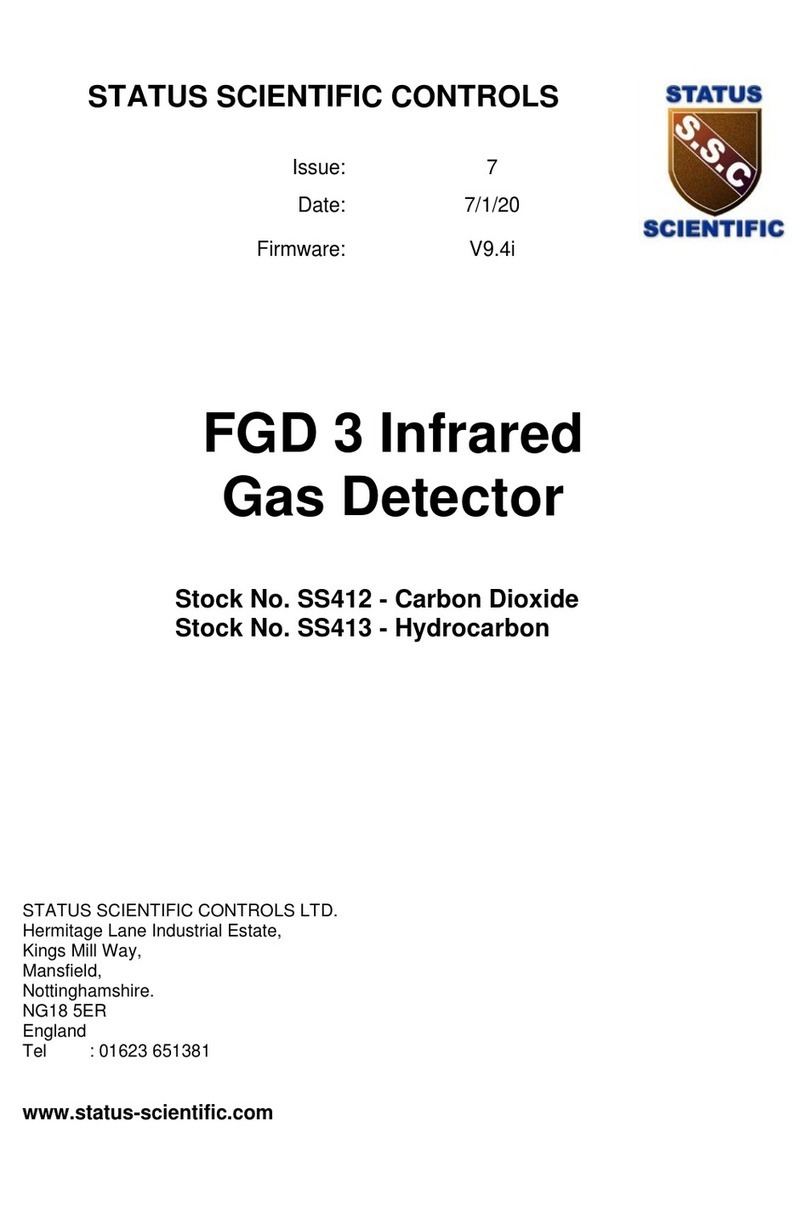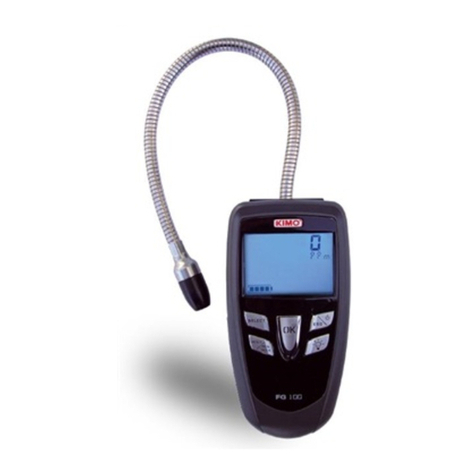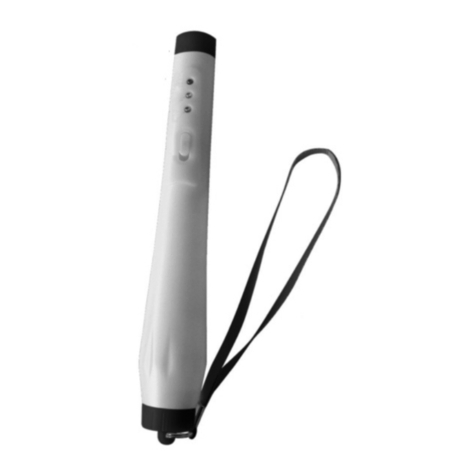Inficon GAS-Mate User manual

OPERATING MANUAL
GAS-Mate®
EN·ES·FR·DE·IT
Combustible Gas Leak Detector

2
Declaration of Conformity
This is to certify that this equipment, designed and manufactured by INFICON
Inc., 2 Technology Place, East Syracuse, NY 13057 USA meets the essential
safety requirements of the European Union and is placed on the market
accordingly. It has been constructed in accordance with good engineering practice
in safety matters in force in the Community and does not endanger the safety of
persons, domestic animals or property when properly installed and maintained
and used in applications for which it was made.
Equipment Description. . . . . . . . . GAS-Mate® Combustible Gas Leak Detector
Applicable Directives . . . . . . . . . . 89/336/EEC as amended by 93/68 EEC
94/9/EC
Applicable Standards . . . . . . . . . . EN61000-6-1, EN61000-6-2, EN61000-6-3,
EN61000-6-4, EN60079-0, EN60079-15
CE Implementation Date . . . . . . . January 20003
Authorized Representative. . . . . . Brian W. King
Business Line Manager, Service Tools
INFICON Inc.
Two Technology Place
East Syracuse, NY 13057
Any questions relative to this declaration or to the safety of INFICON products
should be directed, in writing, to the quality assurance department at the above
address.
GAS-Mate® and INFICON® are registered trademarks of INFICON.
The GAS-Mate is Intrinsically Safe for Class I, Division 1, Groups A-D, T4 and
rated II 3G Ex nA nL IIC T4 X as per Listing Number E112145 by MET
Laboratories, Inc.

3
Introduction
Thank you for buying the INFICON® GAS-Mate Combustible Gas Leak Detector.
The GAS-Mate is an intrinsically safe instrument designed to detect leaks of a
variety of combustible gases. It can be used for many leak testing applications
including, but not limited to:
Combustion appliances
Gas-fired furnaces
Gas stoves
Hydrocarbon-based refrigerants
Gas pipelines, valves and meters
Heat exchanger testing with combustible gases
The GAS-Mate is sensitive to a variety of hydrocarbons and other gases
including, but not limited to:
Natural Gas
Cyclopentane
Isobutane
Methane
Propane
Ethane
Butane
Ammonia
Ethanol
Forming Gas (95% nitrogen, 5% hydrogen)
NOTE: The GAS-Mate does NOT detect carbon monoxide (CO).
To get the best performance from your GAS-Mate combustible gas leak detector,
please read this manual carefully before you start using the instrument. If you
have any questions or need additional assistance, please call
+49 221 56788-660. We'll be happy to help you!

4
GAS-Mate's High Performance Features
Highly advanced thick film, long-life sensor.
Small sensor and probe tip allow leak checking in tight spaces.
Automatic adjustment (zeroing) to combustible gases in leak test area for
greater stability.
Innovative sensitivity touch pad for faster pinpointing of leaks.
Rugged flexible probe.
Variable audible signal as well as multiple LEDs to indicate leaks.
Specifications
Sensitivity. . . . . . . . . . . . . . . . . 5 PPM Methane (main component of natural gas)
Power Supply . . . . . . . . . . . . . . . . . . . . . . . . . . . . . . Two "D" cell alkaline batteries
Battery Life . . . . . . . . . . . . . . . . . . . . . . . . . . . . . . . . . . . . .Approximately 25 hours
Weight (with power cells) . . . . . . . . . . . . . . . . . . . . . . . . . . . . . . . . . 0.7 kg (1.5 lb.)
Product Warnings
WARNING
To prevent ignition of a hazardous atmosphere, batteries must
only be changed in an area known to be nonhazardous
(i.e., completely free of combustible gas).
WARNING
Use only Duracell® MN1300 batteries to maintain intrinsically safe
approval.
WARNING
Check instrument operation with a known combustible leak
source before leak testing.

5
WARNING
The GAS-Mate will detect leaks as described below but may not
indicate when a hazardous atmosphere is present due to its Auto
Zeroing function. Lack of a reading by the GAS-Mate should not
be taken as an indication that the atmosphere is totally safe.
WARNING
There are no user serviceable parts inside. Do not disassemble
the GAS-Mate.
Getting Started
1. The combustible gas sensor is already installed in the GAS-Mate's probe.
No installation of the sensor is necessary.
2. You will need to install the alkaline batteries which are included with your
GAS-Mate. Remove the battery cover by releasing the latch and sliding the
cover down and off the handle. You may need to use a small flat-blade
screwdriver to assist with releasing the latch. Install the two "D" sized Duracell®
MN1300 alkaline batteries as shown in Figure 1, with the positive terminals
pointing toward the end of the handle. Reinstall the battery cover by aligning it
in the grooves on the handle and sliding it up the handle until it latches.
Figure 1 Properly installed alkaline batteries
DURACELL® is a registered trademark of Duracell, Inc., Bethel, Connecticut.
+-+-

6
Using the GAS-Mate
1. Be sure to power the GAS-Mate on in an area known to be free of any
combustible gases, such as outdoors, for ideal leak checking. Depress the
Power button to turn the unit on. Wait for the GAS-Mate to warm up. The high
pitched audible tone will change to a steady beeping and the LEDs will
illuminate briefly. The warm up time is approximately 30 seconds, but will vary
depending on the length of time since the unit was last used. In clean air, the
audio alarm will beep at a slow, steady rate.
The unit will automatically power up in maximum sensitivity. This is the setting
in which most leak-checking should be performed, including searching for very
small leaks. The GAS-Mate has adjustable sensitivity. You can reduce
sensitivity by dragging your finger downwards on the sensitivity touch pad.
This can be helpful for pinpointing the location of larger leaks. The automatic
background zeroing function keeps the instrument stable, eliminating the need
to frequently adjust sensitivity.
2. Carry the GAS-Mate into the area of the suspected leak. An alarm at this time
indicates a build-up of combustible gas in the general area. When the
GAS-Mate detects combustible gas, the rate of beeping of the audio alarm
increases in proportion to the size of the leak detected. The rate of flashing of
the LEDs also increases with an increase in the gas concentration detected.
The automatic background zero function (which is constantly working) will zero
out the background gas and the alarm will slowly return to a slow beeping.
When the unit has stabilized again, proceed towards the suspected leak site.
The GAS-Mate will continue to indicate changes in gas concentration by
alarming as the concentration increases.
3. Move the probe tip slowly (approximately 2-5 centimeters per second) around
suspected leak sites. Try to position the probe tip as close as possible to the
suspected leak site for optimum performance. An increase in the rate of
beeping and flashing LEDs indicates a leak.
4. To confirm a leak, pull the probe away from the suspected leak site and allow
the instrument to return to a steady state. Repeat step 3.
5. After exposure to very high concentrations of some gases, the sensor may
require several minutes to stabilize and return to normal operation.

7
6. The Battery LED will flash when the batteries need to be replaced. The
GAS-Mate will continue to operate for approximately one hour after the Battery
LED begins to flash.
7. Store your GAS-Mate in a clean place, protected from shock, impact, or other
possible damage. We suggest storing it in the hard plastic carrying case that
comes with the unit.
How to Change the Alkaline Batteries
WARNING
To prevent ignition of a hazardous atmosphere, batteries must
only be changed in an area known to be non-hazardous (i.e., free
of combustible gas).
CAUTION
Use only Duracell® MN1300 "D" size batteries to maintain
intrinsically safe approval.
1. Remove the battery cover by releasing the latch and sliding the cover down and
off the handle. You may need to use a small flat-blade screwdriver to assist with
releasing the latch.
2. Remove the used batteries. Insert the two new "D" sized batteries in the battery
compartment with the positive ends facing toward the end of the handle.
3. Reinstall the battery cover by aligning it in the grooves on the handle and sliding
it up the handle until it latches.
Disposing of the Alkaline Batteries
At the end of the life of your alkaline batteries, please dispose of them according
to applicable state and local regulations. In the absence of such regulations,
INFICON encourages its customers to recycle and/or dispose of the cells through
voluntary waste recycling programs.

8
How to Change the Sensor
1. The sensor comes installed in the tip of the GAS-Mate probe. You only need to
insert/remove the sensor when it is time to replace it.
2. Insert a paper clip or a small screwdriver under the sensor through the slot in
the probe tip and carefully slide the sensor out of the end of the probe tip as
seen in Figure 2..
3. Remove the new sensor from its packaging and install it by aligning the tab on
the metal sensor can with the slot in the probe tip and gently sliding the sensor
into the tip. Be certain that the four wire leads on the sensor fit into the four holes
at the base of the probe sensor socket, and that they are not bent during the
installation process.
4. When properly installed, the top of the sensor should be approximately flush
with the tip of the probe.
Figure 2. Replacing the sensor
Alignment Tab

9
Troubleshooting
WARNING
Substitution of components may impair intrinsic safety.
Except for the batteries and the sensor, the internal parts of the GAS-Mate
Combustible Gas Leak Detector are not user serviceable. If you experience a
problem with your GAS-Mate, follow the steps in the trouble shooting guide below
to determine how to remedy your problem. If you cannot remedy the problem, take
your GAS-Mate to your wholesaler for warranty evaluation or call our technical
assistance line at +49 221 56788-660.
Problem Possible Cause Remedy
GAS-Mate will not power
up.
Batteries are worn out. Replace batteries.
Batteries are improperly
installed.
Refer to Figure 1 for
proper installation.
Poor sensitivity. Unit
powers up, but has a
difficult time detecting
combustible gas.
Unit set to low sensitivity. Increase sensitivity by
dragging finger upwards
on touch pad.
Sensor is worn out and
needs to be replaced.
Replace sensor.
Alarm sounds
continuously, even after
a couple minutes of
warm-up.
The sensor is not
installed properly or is
missing.
The sensor leads must
be straight and inserted
in the holes at the base
of the sensor socket. Or,
the orientation tab is not
properly aligned in the
probe tip. Refer to Figure
2..
Sensor is worn out and
needs to be replaced.
Replace sensor.

10
Replacement Parts and Accessories
Replacement parts and accessories for your INFICON GAS-Mate combustible
gas leak detector are available through the same dealer from whom you bought
the instrument.
Plastic storage case. . . . . . . . . . . 718-701-G1
Replacement sensor . . . . . . . . . . 706-700-G1
Warranty and Liability
INFICON warrants your GAS-Mate Combustible Gas Leak Detector to be free
from defects of materials or workmanship for three (3) years from the date of
purchase. INFICON does not warrant items that deteriorate under normal use,
including power cells (batteries) and sensors. In addition, INFICON does not
warrant any instrument that has been subjected to misuse, negligence, or
accident, or has been repaired or altered by anyone other than INFICON.
INFICON's liability is limited to instruments returned to INFICON, transportation
prepaid, not later than thirty (30) days after the warranty period expires, and which
INFICON judges to have malfunctioned because of defective materials or
workmanship. INFICON's liability is limited to, at its option, repairing or replacing
the defective instrument or part.
This warranty is in lieu of all other warranties, expressed or implied, whether of
Merchantability or of Fitness for a particular purpose or otherwise. All such other
warranties are expressly disclaimed.
INFICON shall have no liability in excess of the price paid to INFICON for the
instrument plus return transportation charges prepaid. INFICON shall have no
liability for any incidental or consequential damages. All such liabilities are
excluded.
Return Authorization Procedure
Defective GAS-Mates, or defective replacement parts and accessories, should be
returned to your wholesaler for warranty evaluation. If you have any questions,
please contact INFICON at +49 221 56788-660.
Please do not return your unit directly to the factory without first contacting your
wholesaler.

11
Declaración de conformidad
Por la presente, certificamos que este equipo, diseñado y fabricado por INFICON Inc.,
2 Technology Place, East Syracuse, NY 13057, EE. UU., cumple los requisitos
esenciales de seguridad de la Unión Europea y se distribuye conforme a ellos.
Ha sido construido de acuerdo con las buenas prácticas de ingeniería en materia
de seguridad vigentes en la Comunidad, y no supone ningún peligro para la
seguridad de personas, animales domésticos o propiedades si se instala y
mantiene debidamente y se utiliza en las aplicaciones para las que se ha fabricado.
Descripción del equipo. . . . . . . . . Detector de fugas de gases combustibles
GAS-Mate®
Directivas aplicables . . . . . . . . . . 73/23/EEC según enmienda 93/68/EEC,
89/336/EEC según enmienda 93/68 EEC
94/9/EC
Normas aplicables . . . . . . . . . . . . EN61010-1, EN61000-6-1, EN61000-6-3,
EN60079-0:2009, EN60079-15:2005
Fecha de implementación de la CE Enero de 2000
Representante autorizado . . . . . . Brian W. King
Director de línea comercial,
Herramientas de servicio
INFICON Inc.
Two Technology Place
East Syracuse, NY 13057, EE. UU.
Cualquier pregunta relacionada con esta declaración o con la seguridad de los
productos INFICON®debe dirigirse por escrito al Departamento de Control de
Calidad, a la dirección indicada anteriormente.
El dispositivo GAS-Mate es intrínsecamente seguro para la Clase I, División 1,
Grupos A-D, T4 y está clasificado como II 3G Ex nA nL IIC T4 X según el número
de listado E112145 de MET Laboratories, Inc.
GAS-Mate®e INFICON®son marcas comerciales registradas de INFICON GmbH.

12
Introducción
Gracias por adquirir el detector de fugas de gases combustibles INFICON
GAS-Mate. El detector GAS-Mate es un instrumento intrínsecamente seguro
diseñado para detectar fugas de diversos gases combustibles. Se puede utilizar
en numerosas aplicaciones de detección de fugas, que incluyen, entre otras:
Electrodomésticos de combustión
Hornos a gas
Cocinas de gas
Refrigerantes a base de hidrocarburos
Tuberías, válvulas y contadores de gas
Análisis de intercambiadores de calor con gases combustibles
GAS-Mate detecta diversos hidrocarburos y otros gases que incluyen, entre otros,
los siguientes:
Gas natural
Ciclopentano
Isobutano
Metano
Propano
Etano
Butano
Amoniaco
Etanol
Forming Gas (95% nitrogen, 5% hydrogen)
NOTA: GAS-Mate NO detecta el monóxido de carbono (CO).
Para obtener el máximo rendimiento de su detector de fugas de gases
combustibles GAS-Mate, lea atentamente este manual antes de comenzar
a utilizar el instrumento. Si desea formular alguna pregunta o necesita ayuda
adicional, llame al teléfono +49 221 56788-660. Estaremos encantados de
ayudarle.

13
Características de alto rendimiento del detector GAS-Mate
Sensor de película gruesa muy avanzado y de larga duración.
Sensor y sonda pequeños que permiten comprobar fugas en
lugares estrechos.
Ajuste automático (puesta a cero) a los gases combustibles en la zona
de detección de fugas para una mayor estabilidad.
Innovador control de sensibilidad táctil para detectar fugas con mayor rapidez.
Sonda flexible y resistente.
Indicación de fugas mediante una alarma acústica variable y varios LED.
Especificaciones
Sensibilidad . . . . . . . . . 5 PPM de metano (componente principal del gas natural)
Fuente de alimentación . . . . . . . . . . . . . . . . . . . . 2 baterías alcalinas tamaño "D"
Duración de la batería . . . . . . . . . . . . . . . . . . . . . . . . Aproximadamente 25 horas
Peso (con baterías) . . . . . . . . . . . . . . . . . . . . . . . . . . . . . . . . . . . . . . . . . . . .0,7 kg

14
Advertencias del producto
ADVERTENCIA
Para evitar la ignición de una atmósfera peligrosa, las baterías
sólo se deben cambiar en una zona que se sepa que no tiene
peligro (es decir, completamente libre de gas combustible).
ADVERTENCIA
Utilice solo baterías Duracell®MN1300 para mantener la
aprobación de seguridad intrínseca.
ADVERTENCIA
Compruebe siempre el funcionamiento del instrumento antes del
uso con una fuga de combustible conocida.
ADVERTENCIA
GAS-Mate detectará fugas de la manera descrita a continuación,
pero es posible que no indique la existencia de una atmósfera
peligrosa debido a la función de puesta a cero. La ausencia de
lectura en el GAS-Mate no se debe interpretar como una
indicación de que la atmósfera sea totalmente segura.
ADVERTENCIA
No contiene piezas sustituibles en el interior. No desmonte el
detector GAS-Mate.

15
Procedimientos iniciales
1. El sensor de gases combustibles ya está instalado en la sonda del detector
GAS-Mate. No es necesario instalar el sensor.
2. Se deben instalar las baterías alcalinas incluidas con el detector GAS-Mate.
Abra la tapa de las pilas; para ello, apriete la pestaña y deslice la tapa hacia
abajo alejándola del asa. Es posible que tenga que ayudarse con un
destornillador de cabeza plana. Instale las dos baterías alcalinas Duracell®
MN1300 tamaño "D" de la manera indicada en la Figura 1, con los terminales
positivos hacia el extremo del asa. Vuelva a colocar la tapa de las baterías,
alineándola con las ranuras del asa y deslizándola hacia el asa hasta
que encaje.
Figura 1 Pilas alcalinas instaladas correctamente
DURACELL®es una marca comercial registrada de Duracell Inc., Bethel, Connecticut, EE. UU.
+-+-

16
Uso del detector GAS-Mate
1. Para una comprobación ideal, asegúrese de encender el detector GAS-Mate
en una zona que se sepa que no contiene gases combustibles, como en
exteriores. Pulse el botón de encendido para activar la unidad. Espere a que el
GAS-Mate se caliente. La señal acústica aguda cambiará a un pitido continuo
y los LED se iluminarán brevemente. El tiempo de calentamiento es
aproximadamente 30 segundos, pero variará en función del tiempo transcurrido
desde la última vez que se utilizó la unidad. En aire limpio, la alarma acústica
emitirá pitidos a velocidad lenta y constante.
La unidad se encenderá automáticamente en máxima sensibilidad. Éste es el
ajuste con el que se deben realizar la mayoría de las comprobaciones de
fugas, incluyendo la búsqueda de fugas muy pequeñas. La sensibilidad del
GAS-Mate se puede ajustar. Para reducir la sensibilidad, arrastre el dedo
hacia abajo sobre el control de sensibilidad táctil. Este ajuste puede resultar
útil para señalar la ubicación de fugas más grandes. La función de puesta a
cero automática mantiene la estabilidad del instrumento y elimina la necesidad
de ajustar la sensibilidad con frecuencia.
2. Traslade el GAS-Mate a la zona en la que haya sospecha de fuga. Si en ese
momento suena la alarma, indica que hay una acumulación de gas combustible
en la zona general. Cuando el GAS-Mate detecta gas combustible, la velocidad
de los pitidos de la alarma acústica aumenta en proporción al tamaño de la fuga
detectada. La velocidad de intermitencia de los LED también aumentará al
aumentar la concentración de gas detectada.
La función de puesta a cero automática (que funciona constantemente) pondrá
a cero el gas de fondo y la alarma volverá poco a poco a emitir pitidos lentos.
Cuando la unidad se haya vuelto a estabilizar, diríjase al lugar en el que se
sospecha la fuga. GAS-Mate seguirá indicando cambios en la concentración
de gas mediante la alarma a medida que aumente la concentración.
3. Mueva la sonda lentamente (unos 2-5 cm por segundo) alrededor de los puntos
en los que se sospeche la existencia de una fuga. Para un rendimiento óptimo,
intente colocar la punta de la sonda lo más cerca posible del lugar de sospecha
de la fuga. Un aumento en la velocidad de los pitidos y en la intermitencia de
los LED indica una fuga.

17
4. Para confirmar la fuga, retire la sonda del lugar de sospecha de la fuga y deje
que el instrumento vuelva al estado normal. Repita el paso 3.
5. Después de la exposición a elevadas concentraciones de algunos gases,
el sensor puede necesitar varios minutos para estabilizarse y volver a su
funcionamiento normal.
6. El indicador LED de la batería se iluminará intermitentemente cuando sea
necesario sustituir las baterías. El GAS-Mate seguirá funcionando durante
aproximadamente una hora después de que el indicador LED de la batería
comience a encenderse intermitentemente.
7. Guarde el GAS-Mate en un lugar limpio y protegido frente a golpes, impactos
u otros posibles daños. Recomendamos almacenarlo en la funda de transporte
de plástico rígido que viene con la unidad.

18
Cómo cambiar las baterías alcalinas
ADVERTENCIA
Para evitar la ignición de una atmósfera peligrosa, las baterías
sólo se deben cambiar en una zona que se sepa que no tiene
peligro (es decir, libre de gas combustible).
PRECAUCIÓN
Utilice solo baterías Duracell®MN1300 tamaño "D" para mantener
la aprobación de seguridad intrínseca.
1. Abra la tapa de las pilas; para ello, apriete la pestaña y deslice la tapa hacia
abajo alejándola del asa. Es posible que tenga que ayudarse con un
destornillador de cabeza plana.
2. Retire las baterías usadas. Inserte las dos nuevas baterías tamaño "D" en
el compartimiento de las baterías, con los polos positivos apuntando hacia
el extremo del asa.
3. Vuelva a colocar la tapa de las baterías, alineándola con las ranuras del asa y
deslizándola hacia el asa hasta que encaje.
Cómo desechar las baterías alcalinas
Cuando se agoten las baterías alcalinas, deséchelas de acuerdo con la normativa
local y estatal. Si no existe ninguna normativa al respecto, INFICON recomienda
a los clientes reciclar y/o desechar las baterías a través de programas voluntarios
de reciclaje de desechos.

19
Cómo cambiar el sensor
1. El sensor viene ya instalado en la sonda GAS-Mate. Sólo necesitará
insertar/extraer el sensor cuando haya que sustituirlo.
2. Introduzca un clip para papel o un destornillador pequeño debajo del sensor
a través de la ranura de la punta de la sonda y deslice con cuidado el sensor
hacia afuera del extremo de la punta de la sonda, como se muestra en la Figura 2.
3. Extraiga el nuevo sensor de su embalaje e instálelo alineando la pestaña de la
lata metálica del sensor con la ranura de la punta de la sonda, y deslice
suavemente el sensor dentro de la punta. Asegúrese de que los cuatro
terminales de los cables del sensor encajen en los cuatro orificios de la base
del zócalo de la sonda del sensor, y de que no se doblen durante la instalación.
4. Si se instalan correctamente, la parte superior del sensor debe alinearse más
o menos con la punta de la sonda.
Figura 2 Cómo sustituir el sensor
Pestaña de alineación

20
Resolución de problemas
ADVERTENCIA
La sustitución de componentes puede afectar a la seguridad
intrínseca.
Ninguno de los componentes internos del detector de fugas de gas combustible
GAS-Mate puede ser reparado o sustituido por el usuario, a excepción de las
baterías y el sensor. Si tiene algún problema con su GAS-Mate, siga los pasos
indicados en la guía para la resolución de problemas a continuación para
determinar cómo corregir el problema. Si no puede corregir el problema, lleve el
GAS-Mate al distribuidor para que lo revise en garantía o llame a nuestro teléfono
de asistencia técnica +49 221 56788-660.
Problema Posible causa Solución
El GAS-Mate no
se enciende.
Las baterías están
gastadas.
Sustituya las baterías.
Las baterías no
están instaladas
correctamente.
Consulte la manera de
instalarlascorrectamente
en la Figura 1.
Poca sensibilidad.
La unidad se enciende,
pero tiene dificultades
para detectar el gas
combustible.
El ajuste de sensibilidad
de la unidad es
demasiado bajo.
Aumente la sensibilidad
arrastrando el dedo hacia
arriba sobre el control de
sensibilidad táctil.
El sensor está gastado y
es necesario sustituirlo.
Sustituya el sensor.
Other manuals for GAS-Mate
3
Table of contents
Languages:
Other Inficon Gas Detector manuals
Inficon
Inficon Fab UL6000 Fab User manual
Inficon
Inficon IRwin User manual
Inficon
Inficon UL3000 Fab ULTRA User manual
Inficon
Inficon WHISPER User manual
Inficon
Inficon IRWIN User manual
Inficon
Inficon IRwin S User manual
Inficon
Inficon IRwin S User manual
Inficon
Inficon IRwin Methan Leak Detector User manual
Inficon
Inficon GAS-Mate User manual
